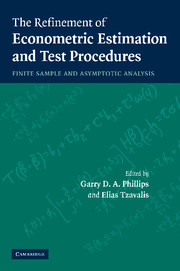Book contents
- Frontmatter
- Contents
- List of figures
- List of tables
- List of contributors
- Preface
- Acknowledgements
- Michael Magdalinos 1949–2002
- Introduction
- 1 Conditional Heteroskedasticity Models with Pearson Disturbances
- 2 The Instrumental Variables Method Revisited: On the Nature and Choice of Optimal Instruments
- 3 Nagar-Type Moment Approximations in Simultaneous Equation Models: Some Further Results
- 4 Local GEL Methods for Conditional Moment Restrictions
- 5 Limit Theory for Moderate Deviations From a Unit Root Under Weak Dependence
- 6 The Structure of Multiparameter Tests
- 7 Cornish-Fisher Size Corrected t and F Statistics for the Linear Regression Model with Heteroscedastic Errors
- 8 Non-Parametric Specification Testing of Non-Nested Econometric Models
- 9 Testing for Autocorrelation in Systems of Equations
- 10 Alternative Approaches to Estimation and Inference in Large Multifactor Panels: Small Sample Results with an Application to Modelling Asset Returns
- 11 Judging Contending Estimators by Simulation: Tournaments in Dynamic Panel Data Models
- 12 A Statistical Proof of the Transformation Theorem
- 13 On the Joint Density of the Sum and Sum of Squares of Non-Negative Random Variables
- 14 Conditional Response Analysis
- References
- Index
10 - Alternative Approaches to Estimation and Inference in Large Multifactor Panels: Small Sample Results with an Application to Modelling Asset Returns
Published online by Cambridge University Press: 22 September 2009
- Frontmatter
- Contents
- List of figures
- List of tables
- List of contributors
- Preface
- Acknowledgements
- Michael Magdalinos 1949–2002
- Introduction
- 1 Conditional Heteroskedasticity Models with Pearson Disturbances
- 2 The Instrumental Variables Method Revisited: On the Nature and Choice of Optimal Instruments
- 3 Nagar-Type Moment Approximations in Simultaneous Equation Models: Some Further Results
- 4 Local GEL Methods for Conditional Moment Restrictions
- 5 Limit Theory for Moderate Deviations From a Unit Root Under Weak Dependence
- 6 The Structure of Multiparameter Tests
- 7 Cornish-Fisher Size Corrected t and F Statistics for the Linear Regression Model with Heteroscedastic Errors
- 8 Non-Parametric Specification Testing of Non-Nested Econometric Models
- 9 Testing for Autocorrelation in Systems of Equations
- 10 Alternative Approaches to Estimation and Inference in Large Multifactor Panels: Small Sample Results with an Application to Modelling Asset Returns
- 11 Judging Contending Estimators by Simulation: Tournaments in Dynamic Panel Data Models
- 12 A Statistical Proof of the Transformation Theorem
- 13 On the Joint Density of the Sum and Sum of Squares of Non-Negative Random Variables
- 14 Conditional Response Analysis
- References
- Index
Summary
Introduction
Panel data-sets have been increasingly used in economics to analyse complex economic phenomena. One of their attractions is the ability to use an extended data-set to obtain information about parameters of interest which are assumed to have common values across panel units. Most of the work carried out on panel data has usually assumed some form of cross-sectional independence to derive the theoretical properties of various inferential procedures. However, such assumptions are often suspect and as a result recent advances in the literature have focused on estimation of panel data models subject to error cross-sectional dependence.
A number of different approaches have been advanced for this purpose. In the case of spatial data-sets where a natural immutable distance measure is available the dependence is often captured through “spatial lags” using techniques familiar from the time series literature. In economic applications, spatial techniques are often adapted using alternative measures of “economic distance”. This approach is exemplified in work by Lee and Pesaran (1993), Conley and Dupor (2003), Conley and Topa (2002) and Pesaran, Schuermann, and Weiner (2004), as well as the literature on spatial econometrics recently surveyed by Anselin (2001). In the case of panel data models where the cross-section dimension (N) is small (typically N < 10) and the time-series dimension (T) is large the standard approach is to treat the equations from the different cross-section units as a system of seemingly unrelated regression equations (SURE) and then estimate the system by the Generalized Least Squares (GLS) techniques.
- Type
- Chapter
- Information
- The Refinement of Econometric Estimation and Test ProceduresFinite Sample and Asymptotic Analysis, pp. 239 - 281Publisher: Cambridge University PressPrint publication year: 2007
- 20
- Cited by



